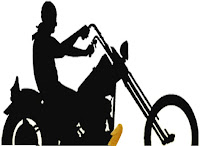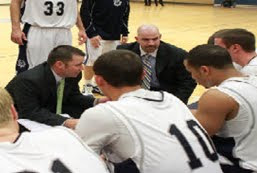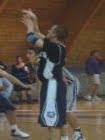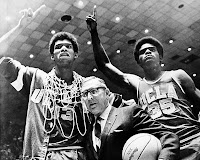
Late last week, as I was making my drive to campus, traffic was really bad. Dallas traffic during morning commute time is already a mess and this day was worse than normal. I pulled up next to a guy on a fully loaded and tricked out Harley chopper.
This machine was a thing of beauty! The custom black paint job sparkled in the sunlight while the huge V-twin rumbled like an active volcano. It was truly a
biker's bike.
The man riding the thunderous two-wheeled demon was clad in riding leathers. His jet black leather jacket was emblazoned with various rally patches and Harley logos. He donned a German army style helmet over a black
bandanna covering his head. Fingerless leather gloves with metal studs on his hands as he gripped the handlebars. His legs were covered in leather riding chaps. All signs pointed to this man being one hardcore rider. A loner. A rebel. Free to ride wherever the road takes him.
There was one sign that totally dispelled any of those perceptions. The man was wearing fur-lined tan house slippers. It was clear to me at that point, this was just a normal "Joe" out for a trip to the grocery store and felt like taking the bike instead of the Clark W. Griswold Wagon Queen Family
Truckster... or the soccer mom minivan.
It was such a striking reminder that in the game of basketball (and probably multiple sports) feet tell the story. Like film, feet don't lie. Feet can determine success or failure.
In regards to shooting, feet are first on the list for a successful shot. Being shot ready, or as Mike
Krzyzewski calls it being "loaded up", the feet come first. Toes pointed to the basket. Shooting foot in front of the other foot in a toe/instep relation. Shoulder width apart. Building a balanced base in order to drive through the shot and land in the same place. Balanced in order to not drift or float.
Feet are the telling tale on defense. Again, balance is the key. A wide stance with one foot slightly in front of the other in a heel/toe relation. The feet should act as a boundary to the shoulders. When the shoulders stray outside of the feet in a lunging fashion, the player becomes off balance and slow. Toes point slightly outward allowing for the player to bend his knees and sit in a stance.
Feet also tell the story of preparedness. Flat feet says that player is slow, unprepared, and about to get beat. With heels slightly off the ground, light, and constantly moving shows that a player is prepared, attack ready, and has the ability to react quickly. Kevin Eastman
would tell our players at Washington State, "Don't get ready to be ready." Players' feet will demonstrate whether they are ready or not. Coach Eastman has some great video on
YouTube demonstrating proper foot readiness on offense.
Just like my weekend warrior friend in traffic, a player may dress the part with the newest gear, headbands, wristbands, etc., but his feet are going to tell you the truth. We must continue at all levels to teach in the fashion of Pete
Newell. Footwork is the key to success!



 You are a player when:
You are a player when:







